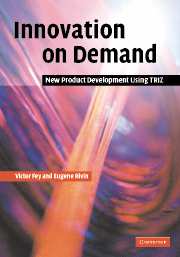Book contents
- Frontmatter
- Contents
- Preface
- 1 Introduction
- 2 Resolving system conflicts
- 3 Basics of the substance–field analysis
- 4 Algorithm for inventive problem solving (ARIZ)
- 5 Laws of technological system evolution
- 6 Guiding technology evolution
- Appendix 1 Genrikh Altshuller – the creator of TRIZ
- Appendix 2 System conflict matrix and inventive principles
- Appendix 3 Standard approaches to solving inventive problems
- Appendix 4 Using TRIZ in management practice
- Appendix 5 Glossary
- References
- Index
1 - Introduction
Published online by Cambridge University Press: 14 January 2010
- Frontmatter
- Contents
- Preface
- 1 Introduction
- 2 Resolving system conflicts
- 3 Basics of the substance–field analysis
- 4 Algorithm for inventive problem solving (ARIZ)
- 5 Laws of technological system evolution
- 6 Guiding technology evolution
- Appendix 1 Genrikh Altshuller – the creator of TRIZ
- Appendix 2 System conflict matrix and inventive principles
- Appendix 3 Standard approaches to solving inventive problems
- Appendix 4 Using TRIZ in management practice
- Appendix 5 Glossary
- References
- Index
Summary
Technology is as old as mankind. Myriad small and large innovations have shaped the world, and are molding the future of civilization. The prevailing majority of these innovations have been developed haphazardly; their creators have not used any organized approach to finding new ideas. Despite the great past achievements of a random approach to innovation (the wheel, the automobile, the radio, the airplane, the computer, antibiotics, to name just a few), that approach has become increasingly inefficient in today's fiercely competitive marketplace. This chapter shows the principal shortcomings of random innovation, and the need to replace it with a method of systematic innovation.
Product development process
Every new product – whether the “product” is a technology, a device or a production process – originates from a new concept. To become a product, a concept must be generated, then evaluated and, finally, developed. This flow of activities constitutes the product development process (PDP) (Fig. 1.1).
The process begins with the recognition of a need. Then, the designer must transform this need into a clearly defined problem, or a set of problems. The output of this stage is a problem(s) statement accompanied by a list of various constraints (e.g., performance specifications, manufacturing limitations, economic conditions, statutory restrictions, etc.).
In the next phase, various conceptual solutions to the problem(s) are generated. Here, the most important decisions are made which bring together engineering, production, and commercial aspects of the problem.
- Type
- Chapter
- Information
- Innovation on DemandNew Product Development Using TRIZ, pp. 1 - 10Publisher: Cambridge University PressPrint publication year: 2005

